Serving Greater Litchfield County and Dutchess County
(860) 868-7535
The Denscot Column
Join us as we explore the many facets of pool ownership!
Different Types of Pool Filters
As we discussed in our last entry, there are three types of pool water filters: cartridge, diatomaceous earth, and sand, so named because of the filter media each uses to keep the water free from debris.
Cartridge filters have been in use in the pool industry for more than forty years and are still gaining popularity. These are a great option for many homeowners. The cartridge filter media itself is a spun-bonded polyester fabric and looks rather like the air filter screens you find in many homes. This fabric is folded into dozens-or even hundreds- of pleats and fastened around a cylindrical core. The amount of pleats indicates the total square footage of surface area your cartridge consists of, and therefore how much square footage of filter fabric that is available to clean your water. The white bands that are wrapped around the pleats are attached to each fold to hold everything uniform, which gives the best chances of everything being cleaned thoroughly. The end caps can vary in appearance and function. Some are hollow, some are closed, some have handles, and some have threads. The central core that holds everything together is hollow and has lots of uniform inlets throughout it. This allows the water that has passed through the filter fabric to not remain trapped in the cartridge, but to spill down through the core and back into the PVC lines that will carry it on to the rest of the pool’s return system.
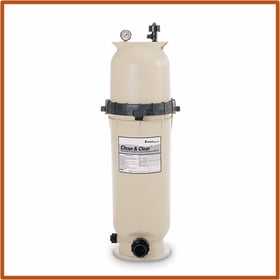
Because cartridges themselves are so simple to clean and replace, they are the ideal option for many homeowners. It provides them with independence and affordability. Cartridge filters also do not require backwashing, making them more environmentally conscious. They are the most common choice for hot tub manufacturers and can even be set up before the pump directly under the skimmer of many above ground pools in the vacuum style filter system we mentioned last week.
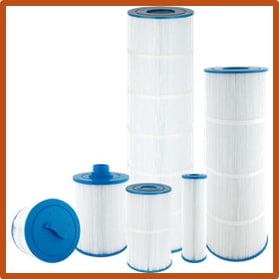
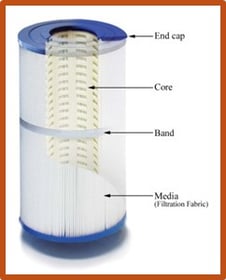
Diatomaceous earth (D.E.) filters use a sedimentary rock called diatomaceous earth to filter the water the gets pumped through them. In the simplest of simple terms, D.E. is a ground powder made up of fossilized algae organisms. While DE is soft to the touch for us, microscopically the silica skeletons are sharp and jagged, much like broken glass. Slugs, snails, beetles, and other bugs avoid crawling over it, and it is often used as a barrier around growing plants. We tell all our technicians and customers who purchase DE through our store to be careful not to breathe in the DE when they are adding it to their filters. Masks and eye protection are encouraged to prevent any potential unintentional contact.
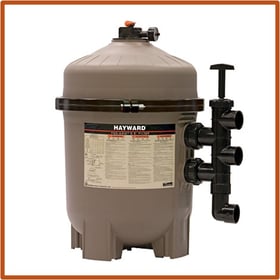
Now, the very same reason that DE is dangerous to bugs makes it beneficial to pool-owners and makes it one of the best options for pool filters. Those miniscule fingers grab up even the tiniest particles of dirt and debris, making DE a very thorough filter media. Water is piped to the top of a DE tank, where it then passes through multiple layers of filter screens. These screens, also called filter elements, or septum, are a rigid grid system covered with a synthetic fabric. The DE (added through the skimmer pot) clings to these elements, and creates even smaller screens through which debris must pass. As the DE catches more debris, these screens grow smaller, effectively becoming more effective. Oftentimes, backwashing a DE filter will reset the filter and you can clean the elements thoroughly and add fresh DE. You can tell when it may be time to backwash and clean your filter by the pressure gauge at the top of the tank.
DE filters are very thorough, and there’s certainly something to be said for their relatively low cost. They are a little more involved, maintenance-wise, and for homeowners looking to save time, DE might not be the way to go.
Sand filters are like DE in that the filter works in a top to bottom way. Water enters the tank near the top of the tank via the diffuser, also called a baffle or splash plate. This baffle is essentially a shower head, and releases the water evenly across the surface of the sand. The water then trickles through the sand to the bottom of the tank where it reaches the laterals. The laterals are a series of arms, it looks kind of like wheel spokes, that are full of sieve-like slits, too small for the sand to get in, but perfect for allowing the freshly filtered water through. Once inside these laterals, the water is then pushed back out into the rest of the PVC system by the pressure in the filter tank. As dirt and debris is filtered out of the water and trapped in the sand, the filter sand will continue to remove finer and finer particles. Eventually this accumulated thickening of the sand media will slow the flow of water, increasing the pressure read on the pressure gauge, and you will know it is time to backwash your filter.
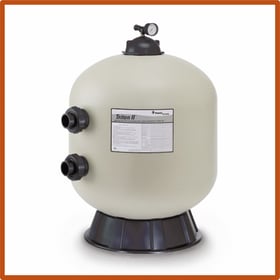
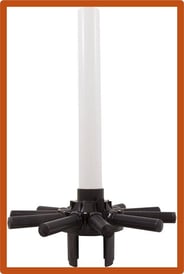
Sand based water filtration has been in use in some form or another since ancient Rome. It is one of the most trusted filtering methods, and one of the most cost efficient, energy efficient, and time efficient choices when it comes to pool filtration. One of the keys to the sand filter’s success is to not over backwash. Backwashing too much will keep the sand clean, and if the sand is clean, it doesn’t have a chance at catching the finer particles it would be able to if you allowed the dirt to accumulate a little. Don’t fill the tank too full of sand either. There should be 8-12 inches off clearance between the top of the level sand bed and the baffle. If there is too much sand, backwashing can cause sand to be lifted up into the standpipe, which will put sand back into your pool.
Clearly there are so many options to consider when choosing a filter for your pool. DE is thorough, sand is low maintenance, cartridge is versatile, and when properly cleaned and maintained, each of these filter types are key assets when keeping your pool clean and clear.
